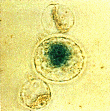
Identification of Plant Genes Involved in
Agrobacterium-Mediated Transformation
Home
Annual Research
Reference List
Links to Related Projects
Site Index
Progress Reports
![]()
Our objectives are to identify plant genes involved in Agrobacterium-mediated genetic transformation, and subsequently to utilize this information to improve the genetic transformation of maize and to prevent crown gall disease on grape.
Agrobacterium-mediated transformation is the most popular method currently in use for generating transgenic plants. However, there are many aspects of the transformation process that are poorly understood. Specifically, little is known about the roles the host genes and proteins play in Agrobacterium-plant cell interactions. Understanding of the plant contribution to the transformation process will certainly result in new technologies for genetic manipulation of agronomically important species that are presently recalcitrant to Agrobacterium-mediated transformation. For example, many plants can be relatively efficiently transformed transiently by Agrobacterium, yet their stable transformation remains elusive. It is likely that these crops are deficient in T-DNA integration. An understanding of the plant genes involved in the integration process may allow us to devise strategies to over-express homologues of these genes in the recalcitrant species and alter them to transformation-competence. On the other hand, inactivation of the same genes in susceptible plants will make them crown gall-resistant. Crown gall disease affects numerous target crop species, and its prevention would be important for many sectors of the agricultural community.
We shall take four approaches to identify and characterize plant genes involved in Agrobacterium-mediated transformation: 1) We shall screen the existing collections of T-DNA-tagged Arabidopsis mutants for rat (resistant to Agrobacterium transformation) phenotypes. We shall investigate these mutants genetically and biochemically to identify the specific stage at which the transformation process is arrested; 2) We shall use the yeast one- and two-hybrid systems to identify plant proteins that interact with Vir (virulence) proteins transferred to the plant by Agrobacterium. These Vir proteins include VirF, VirB2, VirD2, and VirE2; 3) We shall utilize differential display, microarray, and subtraction approaches to identify plant genes up- or down-regulated during early stages of Agrobacterium-mediated transformation; 4) We shall characterize Arabidopsis genes involved in Agrobacterium-mediated transformation using reverse genetics, and examine the functions of proteins encoded by these genes using specific biological assays developed in each of the collaborating laboratories.
Finally, we shall use the information gained from our analysis of Arabidopsis genes to genetically modify maize such that it will become more susceptible to Agrobacterium-mediated transformation, and to genetically modify grape such that it will become resistant to crown gall disease.